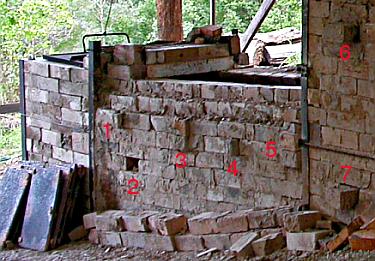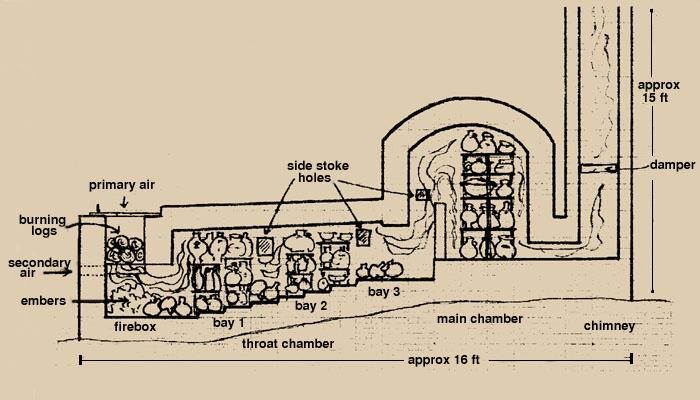|

|
Firing Andrew´s
kiln
SideStoke
home
| Andrew
home | Kiln
home
|
|
Carol
looked at the photos of Andrew´s kiln and wanted to know how
it was fired, so I emailed some questions to him, using the photo
at right for reference. His reply referred to a further diagram
which is reproduced below, along with the questions and his
answers.
|

|

Andrew:
I have attached a cross-section of my kiln which may be of some use
to look at in conjunction with your photo. I have since altered the
floor of the throat to make the steps two bricks long instead of one.
It was too hard to pack with all those little steps. The illustrated
pack is denser than anything I can actually achieve. I now use only
one bung of shelves in the first bay. More space was needed there for
flame expansion and the top front was always a cold spot. The diagram
shows the sidestoking ports, corresponding to 3, 5 and 6 on your
photo, but does not show the mouseholes. There are three, one at the
front of the firebox and one on each side of it, at the level of the
floor. There's another one on each side of behind (in front of?) the
bagwall at position 7.
Do you keep the main
firebox going throughout?
Yes, I do, even if it is only
ticking over. I think of it as an old V8 burbling away with lots of
deep down reserve power. The sidestoking ports can give a quick burst
but have insufficient "grate area" or regulated air supply
(see below) to keep the kiln going on their own. They may do so in a
no-bulli-gama (1) but not when
there is a whole chamber tacked on the end.
When
do you start sidestoking?
No hard and
fast rule for this. There are two considerations: moving thefire
along the kiln to narrow the temperature difference between front
andback; and getting enough reduction at the end of the throat and in
thechamber. The first bay of the throat can be at 1100 or even 1200
before cone06 starts moving in the second bay, while the chamber may
only be 500 or 600. I would probably begin by stoking at 3 at this
stage to try to drop 06 in the second bay in a reducing atmosphere. I
might stoke a bit at 5 aswell, depending on how I feel about the
overall state of the kiln.I used to think it was better to start
sidestoking early, before the first bay got too hot in case I ended
up overfiring it. I thought there would be some virtue in trying to
get the kiln even, before top temperature, and then bring it all up
together. I now think that's probably impossible and even though cone
12 is flat at the front it never gets any hotter and [the clays I
use] can withstand long times at high temperatures, the longer the
better actually.
Once started do you
sidestoke all the throat ports all the time ?
More
or less, although I usually concentrate on one set at a time
according to where I think the heat is needed. This also gives the
other one a chance to burn down since they can get quite full.
Do
you stoke the main chamber directly?
Yes,
eventually I always end up stoking at 6 because I don't think the
chamber is ever going to make it. There's a big difference in the
effect of stoking right behind the bagwall at 6 compared to 5.
Sometimes I may stoke in a wave: 3 then 5 then 6 and back to 3 again
to pull the fire through. It's a long way for the flame to travel
from the firebox to the other end of the kiln without some help along
the way. Yet it's surprising how just a tickle of a sidestoke can
result in a very quick rise and an impressive flame at the top of the
chimney. I would like to try a firing with no sidestoking to see if
it could be done and how long it would take. I suspect it would be a
struggle and the results might be a bit bland but it would be much
less work (splitting as well as stoking) even if the firing took
longer.
The bricks near the numbers
[on the photo]seem to be removable. What
are they all for?
Of the numbers I
have not already identified, 1 and 4 are spyhole bricks and 2 is
where a thermocouple goes in.
Are there any
ports on the other side of the kiln? Do you have any air intakes and
grates below the sidestoke ports as does Sandra Lockwood?
There
are stoking ports in exactly the same positions on the other side of
the kiln as well as a couple more spyholes. Grates and air intakes
would probably improve their performance markedly. They are pretty
inefficient as they are and not all that easy to use.
What
do you do with the damper, and why? It seems to me that if you can
get this kiln to fire reasonably evenly then we should have been able
to get our old
salt kiln to fire more
evenly than we ever did. We never knew what to do with the damper.
I
have to admit that often I am puzzled too. There is a school of
thought that says you should be able to fire with the damper wide
open, using only the air controls at the front of the kiln but I
haven't been able to do it. This kiln can pull a lot of air. The
chimney is one and a half bricks square internally and there is all
that horizontal draught as well as vertical. I don't think the
firebox is big enough to keep up with the draught and it's all too
easy to pull excess cold air through and lose temperature. Observing
the behaviour of the fire at start of the firing (fire on the firebox
floor) is instructive. If the damper is open the fire is erratic,
flaring up and dying back quickly with consequent cycles of soaring
and plummeting temperature, impossible to stabilise. This occurs even
if the stokehole is virtually closed. It is much more manageable with
the damper set at a bit less than half from the start and it will
rarely exceed this at any stage of the firing. In fact it seems to
need closing to 20% or 30% for reduction or even less to get decent
back pressure (2) from the
spyholes in the chamber.
It's easy to succumb to worry that you're
not getting anywhere and to keep fiddling with the damper with an eye
on the digital pyrometer. These quick reacting pyrometers have
developed in tandem with lightweight kilns. There's a lot of inertia
in a brick kiln and you just have to be patient and watch the flame.
A nice fat, lazy flame takes time, not big draughts of cold air. If
I'm honest I must say that I don't really know what I'm doing a lot
of the time. There are a lot of variables, not least the fuel. I'm
still learning the kiln. I've only fired it ten times and with
different people, including Bob Connery and Colin Drake, who have all
had their ideas too. There are lots of ways to fire it. Once I fired
to cone 12 in the first bay, cone 10 in the second and a load of
planters to between cones 03 and 2 in the chamber with no attempt
(and no necessity) to even out the temperature.
How
even is the temperature in the main chamber, at best, when you
finally decide to go to bed?
Looking
back over the logs I see that the cones have been pretty even over
the last four or five firings, at least cone 10 consistently on the
bottom with cone 12 moving higher up. Sometimes cone 12 is nearly
half down on the bottom too. As for the pots themselves, they can be
a little cool down near the exit flues and perhaps all the way down
the back wall. But if there's a good soak it's not too bad.
(1)
The term no-bull-i-gama
was used by Steve Harrison as the name for a kiln of his
which is essentially the same as Andrew´s kiln with the chamber
removed and with a horizontal throat.
(2)
Back pressure refers to the
situation where flames tend to come out of the spyhole when the
spyhole brick is removed.
SideStoke
home |
Andrew
home | Kiln
home
![]()

